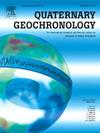The impact of data reduction on classical and Bayesian 210Pb dating models
IF 2.5
2区 地球科学
Q3 GEOGRAPHY, PHYSICAL
引用次数: 0
Abstract
Accurate dating of sediment layers is vital for deciphering Earth’s environmental history. This study addresses the precision and accuracy of lead-210 (210Pb) dating models, a critical tool in sedimentary research for understanding environmental changes. Traditional Constant Rate of Supply (CRS) methods, while widely used, often struggle with accuracy, particularly in complex sedimentation scenarios. We contrast the CRS model with Plum, an advanced Bayesian approach, using simulated 210Pb profiles derived from varied sedimentation processes. Our analysis reveals that even under ideal CRS conditions, the model’s precision does not significantly improve with additional data. In the contrary, Plum consistently outperforms CRS in both accuracy and precision, even with limited data inputs. As data volume increases, Plum’s performance improves markedly, unlike CRS. The Bayesian framework effectively addresses the complexities overlooked by CRS, demonstrating its superiority in refining sediment chronologies. This paper highlights the importance of incorporating statistical advancements in sediment dating techniques. By applying refined Bayesian methods like Plum, researchers can achieve more reliable sediment chronologies, essential for robust environmental studies and unravelling complex climate histories. Our findings suggest that embracing statistical innovations in geochronology can substantially enhance our understanding of Earth’s environmental changes.
数据约简对经典和贝叶斯210Pb测年模型的影响
沉积层的准确年代对于破译地球环境史至关重要。铅-210 (210Pb)定年模型是沉积研究中了解环境变化的重要工具,本研究解决了铅-210 (210Pb)定年模型的精度和准确性。传统的恒定供给率(CRS)方法虽然被广泛使用,但往往存在准确性问题,特别是在复杂的沉积情况下。我们将CRS模型与Plum(一种先进的贝叶斯方法)进行了对比,使用了来自不同沉积过程的模拟210Pb剖面。我们的分析表明,即使在理想的CRS条件下,模型的精度也不会随着额外数据的增加而显著提高。相反,即使在数据输入有限的情况下,Plum在准确性和精密度方面始终优于CRS。随着数据量的增加,Plum的性能显著提高,这与CRS不同。贝叶斯框架有效地解决了CRS忽略的复杂性,显示了其在精炼沉积物年表方面的优势。本文强调了在沉积物测年技术中纳入统计进展的重要性。通过应用像Plum这样的精细贝叶斯方法,研究人员可以获得更可靠的沉积物年表,这对于稳健的环境研究和揭示复杂的气候历史至关重要。我们的研究结果表明,在地质年代学中采用统计创新可以大大提高我们对地球环境变化的理解。
本文章由计算机程序翻译,如有差异,请以英文原文为准。
求助全文
约1分钟内获得全文
求助全文
来源期刊

Quaternary Geochronology
地学-地球化学与地球物理
CiteScore
4.40
自引率
22.20%
发文量
130
审稿时长
20 weeks
期刊介绍:
Quaternary Geochronology is an international journal devoted to the publication of the highest-quality, peer-reviewed articles on all aspects of dating methods applicable to the Quaternary Period - the last 2.6 million years of Earth history. Reliable ages are fundamental to place changes in climates, landscapes, flora and fauna - including the evolution and ecological impact of humans - in their correct temporal sequence, and to understand the tempo and mode of geological and biological processes.
 求助内容:
求助内容: 应助结果提醒方式:
应助结果提醒方式:


